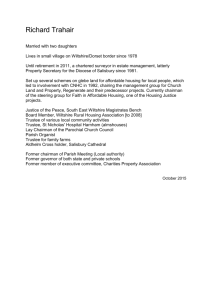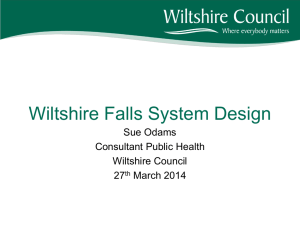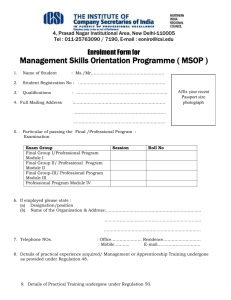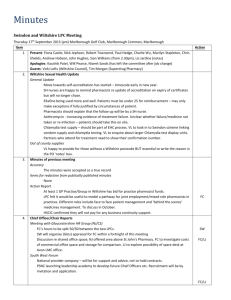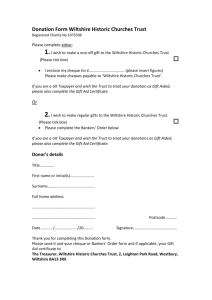Teacher Notes - HoAW Key Stage 1
advertisement
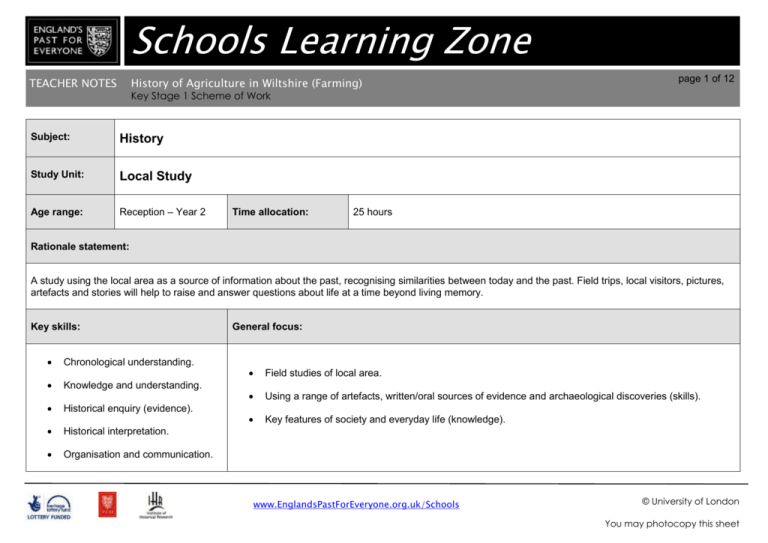
Schools Learning Zone TEACHER NOTES History of Agriculture in Wiltshire (Farming) page 1 of 12 Key Stage 1 Scheme of Work Subject: History Study Unit: Local Study Age range: Reception – Year 2 Time allocation: 25 hours Rationale statement: A study using the local area as a source of information about the past, recognising similarities between today and the past. Field trips, local visitors, pictures, artefacts and stories will help to raise and answer questions about life at a time beyond living memory. Key skills: Chronological understanding. Knowledge and understanding. Historical enquiry (evidence). Historical interpretation. Organisation and communication. General focus: Field studies of local area. Using a range of artefacts, written/oral sources of evidence and archaeological discoveries (skills). Key features of society and everyday life (knowledge). www.EnglandsPastForEveryone.org.uk/Schools © University of London You may photocopy this sheet TEACHER NOTES page 2 of 12 History of Agriculture in Wiltshire (Farming) Key Stage 1 Scheme of Work Prior learning: To already have some degree of personal experiences/knowledge of the local area. To have heard stories from past times. Worked with sources from the past such as artefacts, pictures and people. Started to develop observation and simple recording skills. Begun to answer simple questions about the past. Carried out sorting and sequencing tasks. Expectation: Most pupils will … Identify features of the local area today and a time beyond living memory. Recognise artefacts from the past and present. Know how and where artefacts were used. Handle, observe and draw objects in order to find out about them. Use appropriate language in talking, writing and role-play. www.EnglandsPastForEveryone.org.uk/Schools © University of London You may photocopy this sheet TEACHER NOTES page 3 of 12 History of Agriculture in Wiltshire (Farming) Key Stage 1 Scheme of Work Some children will not have made so much progress and will … Some children will have progressed further and will: Identify some characteristics of the local area. Talk about their experiences in the local area. Describe and handle objects of the past. Make comparisons across time periods. Identify and describe a range of features in the local area and those from the past. Compare aspects of life now and in the past beyond living memory. Explain why people from different societies do different things. www.EnglandsPastForEveryone.org.uk/Schools © University of London You may photocopy this sheet TEACHER NOTES page 4 of 12 History of Agriculture in Wiltshire (Farming) Key Stage 1 Scheme of Work Key content Learning objectives Learning outcomes Assessment Strand P Level / Working towards Chronology Talk about significant events through time in local area (e.g. Agriculture in Living Memory, Agriculture Revolution, Medieval Farming, and late Pre-history). Sort information into chronological order. Explain the reasons for the order using appropriate timerelated vocabulary. To sequence evidence about the local area into three different time periods. 1a Use terms – tomorrow, yesterday, today. 1b Sequence events of the day and the week. Level 1 Level 2 Level 3 Recognise distinction between present and past in own lives and those of others. Consider time beyond living memory (e.g. family tree) and recognise their own lives are different from people in the past. Sequence events using a time line and explore measures of time. Recognise some of the similarities and differences between different periods of time. Place a few objects/events/ pictures in order. www.EnglandsPastForEveryone.org.uk/Schools Develop a timeline to show understanding that the past can be divided into different periods of time. © University of London You may photocopy this sheet TEACHER NOTES page 5 of 12 History of Agriculture in Wiltshire (Farming) Key Stage 1 Scheme of Work Geography Historical enquiry Locate ‘where we live’ and key features on different maps through time. Use maps and look for similarities and differences (symbols / features). Have first-hand experience of the local area through field trips, artefacts, local memories etc. (What can we find out? How do we know?) Begin to gather information from a range of sources and answer questions. Know about location of the local area. 2a Stepping Stones ELG. Sense of time. Begin to recognise that the area has changed at different times in the past and describe some of the characteristic features. Understand the need for evidence. Use different sources of evidence to discover things from the past and begin to use questions as a basis for enquiry. Know about the past and present events in their own lives/ their families /others. 4b www.EnglandsPastForEveryone.org.uk/Schools Show knowledge of events in their own lives and use everyday terms about the passing of time. Show factual knowledge of the past beyond living memory and some of the main events. Show a knowledge and understanding of the main events, people and changes in a period of time. Observe and handle an increasing range of historical sources to answer questions. Use sources of information in ways that go beyond simple observations to answer questions. © University of London You may photocopy this sheet TEACHER NOTES page 6 of 12 History of Agriculture in Wiltshire (Farming) Key Stage 1 Scheme of Work Historical interpretation: Artefacts/resources ‘What was it like?’ Historical Enquiry: Written/oral sources ‘What was it like?’ Find out about the local area in the past and present through handling artefacts, pictures and photographs. Identify similarities and differences. Find out about the local area through looking at different kinds of written sources (e.g. parish register). Use artefacts pictures, photographs to discover things about the past. 3a 3b Handle and compare different objects/pictures from different times. Begin to give reasons for change based on evidence. Can ask and answer questions about aspects of the local area past and present in order to find out what it was like. Look/listen for clues associated with the local area to help understanding. Introduce different sources of historical information (e.g. memories, photographs, artefacts). Can compare two versions of the same event and consider why versions differ. 4a Find out and ask questions about events in their own lives. www.EnglandsPastForEveryone.org.uk/Schools Find answers to some simple questions about the past from sources of information. Identify some ways in which the past is represented (e.g. writings, museums and buildings) beyond their living memory. Identify and make use of different ways in which the past is represented. Give reasons and the results of the main events and changes in time. Distinguish between different versions of events beyond living memory and think about why things happened or changed. Begin to raise questions about time beyond living memory. Raise questions for different lines of enquiry. © University of London You may photocopy this sheet TEACHER NOTES page 7 of 12 History of Agriculture in Wiltshire (Farming) Key Stage 1 Scheme of Work Knowledge and understanding ‘Why…?’ Have 1st hand experience of oral evidence (e.g. local farmers/residents from different generations). Think about the difference between telling facts/tales (opinions). Use what has already been found out about the local area and think about / discuss why: people did what they did, events that happened as a result. Begin to recognise that historical accounts can be influenced by personal opinion. Identify differences between the ways of life in the local area past and present and give reasons why. 2b www.EnglandsPastForEveryone.org.uk/Schools Begin to recognise reasons why people in the past acted as they did. Recognise reasons why people in the past acted as they did. © University of London You may photocopy this sheet TEACHER NOTES page 8 of 12 History of Agriculture in Wiltshire (Farming) Key Stage 1 Scheme of Work Organisation and communication To present what they have learnt about the local area, showing how and why they have changed. To select important information about the local area in the past and present and record by drawing, writing, role play etc. 5a Sort objects/pictures into old and new. Distinguish between old and new. 5b Talk about objects and pictures old and new. Talk about significant events and things in the past, using everyday terms. www.EnglandsPastForEveryone.org.uk/Schools Identify differences between time in their own life and time beyond living memory. Identify and show differences between time in their own life and time beyond living memory. Present findings about objects, people or events. Present and organise own findings about objects, people or events in the past. © University of London You may photocopy this sheet TEACHER NOTES page 9 of 12 History of Agriculture in Wiltshire (Farming) Key Stage 1 Scheme of Work English links: ICT links: Guide books. Creating a website of resources. Narrative – guided reading. Local websites (school, Victoria County History and EPE Schools Learning Zone sites). Non-chronological reports. Internet research/ virtual visits/ CD Roms. Presentations. Graphic modelling. Communicating strand. Infomapper – has maps and aerial photos of the area in 2000 – can compare changes with now. Note taking. Recounts – news, reports, first person recounts). Role play / Drama. Story Telling. Research. Oral presentation. Name derivations (e.g. Coda ford) Letters – asking for information, as source of evidence etc. www.EnglandsPastForEveryone.org.uk/Schools © University of London You may photocopy this sheet TEACHER NOTES History of Agriculture in Wiltshire (Farming) page 10 of 12 Key Stage 1 Scheme of Work Links with other subjects / possible approaches: Geography: Local area. Numeracy: Data handling – census materials,, surveys, graphs – e.g. population, erosion, building developments, comparative , timelines. Science: Link to materials (woollen industry etc). R.E: Wax rubbings from local churches, head stones etc. church history – using graveyards to find out about families etc, importance of religion in community and how this has effected change. Art: My favourite things – abstract pictures resulting from the exploration of a collection of common images, architecture and changing landscapes, then and now themes – photography etc capturing daily life. Design and Technology: could link to a structures unit looking at buildings for example. Comparing both villages (Codford and Steeple Langford) considering changes and reasons for them – are there similar factors (e.g. impact of War, industrial revolution, larger cities and transport forcing village shops and services to close or cease?). www.EnglandsPastForEveryone.org.uk/Schools © University of London You may photocopy this sheet TEACHER NOTES page 11 of 12 History of Agriculture in Wiltshire (Farming) Key Stage 1 Scheme of Work Key vocabulary: Resources: Words associated with the local area, e.g. Wylye, Codford, Steeple Langford, Lakes, Water meadows, Agriculture, transport. Words associated with historical sources, e.g. census, trade/street directories, oral history, documents. Words associated with historical research, e.g. decade, century, generation, ancestor. Words associated with buildings, e.g. factory, industry, storey, semidetached, detached, gable, lintel, arch, sash window, casement window, bay, dormer, barge board, finial, pediments, lychgate, churchyard, tower, steeple, gargoyle, corbel, nave, aisle. Local area! Wiltshire and Swindon library resources. Ordnance survey – including online features. Infomapper. Local museums. Photographs (CD produced by a local resident in Codford – Codford village website). Newspapers – archives in libraries/online. Television programmes/videos where local area been featured in the news / home videos. Villagers. John Chandler from Victoria County History – local Historian. Romy Wyeth – has a book on Codford’s history with photos. England’s Past for Everyone’s paperback Codford: Wool and War in Wiltshire. www.EnglandsPastForEveryone.org.uk/Schools © University of London You may photocopy this sheet TEACHER NOTES page 12 of 12 History of Agriculture in Wiltshire (Farming) Key Stage 1 Scheme of Work Useful contacts: Possible visits / visitors: Established farmers in community. Farms. Romy Wyeth (local archaeological activities and findings). Langford lakes. The Trowbridge museum. Thomas Crockford’s church. Wessex Archaeology. Butts Hill in Hampshire. Wiltshire Heritage Museum. Local residents. Anzac memorial. Romy Wyeth. Lots of exploring the villages. www.EnglandsPastForEveryone.org.uk/Schools © University of London You may photocopy this sheet

